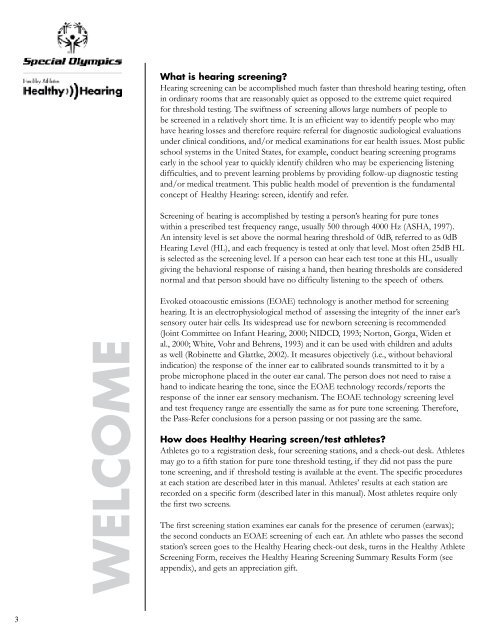Healthy Hearing Program - Special Olympics
Healthy Hearing Program - Special Olympics
Healthy Hearing Program - Special Olympics
Create successful ePaper yourself
Turn your PDF publications into a flip-book with our unique Google optimized e-Paper software.
3<br />
WELCOME<br />
What is hearing screening?<br />
<strong>Hearing</strong> screening can be accomplished much faster than threshold hearing testing, often<br />
in ordinary rooms that are reasonably quiet as opposed to the extreme quiet required<br />
for threshold testing. The swiftness of screening allows large numbers of people to<br />
be screened in a relatively short time. It is an efficient way to identify people who may<br />
have hearing losses and therefore require referral for diagnostic audiological evaluations<br />
under clinical conditions, and/or medical examinations for ear health issues. Most public<br />
school systems in the United States, for example, conduct hearing screening programs<br />
early in the school year to quickly identify children who may be experiencing listening<br />
difficulties, and to prevent learning problems by providing follow-up diagnostic testing<br />
and/or medical treatment. This public health model of prevention is the fundamental<br />
concept of <strong>Healthy</strong> <strong>Hearing</strong>: screen, identify and refer.<br />
Screening of hearing is accomplished by testing a person’s hearing for pure tones<br />
within a prescribed test frequency range, usually 500 through 4000 Hz (ASHA, 1997).<br />
An intensity level is set above the normal hearing threshold of 0dB, referred to as 0dB<br />
<strong>Hearing</strong> Level (HL), and each frequency is tested at only that level. Most often 25dB HL<br />
is selected as the screening level. If a person can hear each test tone at this HL, usually<br />
giving the behavioral response of raising a hand, then hearing thresholds are considered<br />
normal and that person should have no difficulty listening to the speech of others.<br />
Evoked otoacoustic emissions (EOAE) technology is another method for screening<br />
hearing. It is an electrophysiological method of assessing the integrity of the inner ear’s<br />
sensory outer hair cells. Its widespread use for newborn screening is recommended<br />
(Joint Committee on Infant <strong>Hearing</strong>, 2000; NIDCD, 1993; Norton, Gorga, Widen et<br />
al., 2000; White, Vohr and Behrens, 1993) and it can be used with children and adults<br />
as well (Robinette and Glattke, 2002). It measures objectively (i.e., without behavioral<br />
indication) the response of the inner ear to calibrated sounds transmitted to it by a<br />
probe microphone placed in the outer ear canal. The person does not need to raise a<br />
hand to indicate hearing the tone, since the EOAE technology records/reports the<br />
response of the inner ear sensory mechanism. The EOAE technology screening level<br />
and test frequency range are essentially the same as for pure tone screening. Therefore,<br />
the Pass-Refer conclusions for a person passing or not passing are the same.<br />
How does <strong>Healthy</strong> <strong>Hearing</strong> screen/test athletes?<br />
Athletes go to a registration desk, four screening stations, and a check-out desk. Athletes<br />
may go to a fifth station for pure tone threshold testing, if they did not pass the pure<br />
tone screening, and if threshold testing is available at the event. The specific procedures<br />
at each station are described later in this manual. Athletes’ results at each station are<br />
recorded on a specific form (described later in this manual). Most athletes require only<br />
the first two screens.<br />
The first screening station examines ear canals for the presence of cerumen (earwax);<br />
the second conducts an EOAE screening of each ear. An athlete who passes the second<br />
station’s screen goes to the <strong>Healthy</strong> <strong>Hearing</strong> check-out desk, turns in the <strong>Healthy</strong> Athlete<br />
Screening Form, receives the <strong>Healthy</strong> <strong>Hearing</strong> Screening Summary Results Form (see<br />
appendix), and gets an appreciation gift.

















